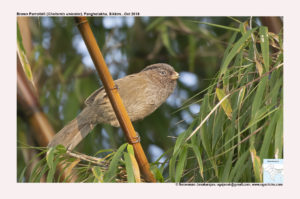
Brown Parrotbill Cholornis unicolor
Etymology:
- Cholornis :Greek word kholos – defective; ornis – bird
- Unicolor : Latin word uni– single-; color-colour { Plain}
Vernacular Name: Lepcha: Lho-ramnio-pho
Distribution in India: Resident of Himalayas India.
Description:
Size of 21 cm; Wt. of male is 32–39 g, wt. of female is 31·5–32 g. It has dark brown-grey forehead to crown with darker feather centers fading to nape, giving slight mottled appearance. It has a blackish supercilium, greyish eyering broken at front and rear; upperparts and upperwing-coverts are mostly warm dark brown; flight-feathers and tertials are with buff inner fringes, dull rufescent outer fringes noticeably warmer than upperparts, outer fringes of primaries P4-P10 are paler and slightly greyer towards tips. The uppertail is brown, with only little grey; cheek to head side is brown with dull chestnut tinge or dark vinous-tinged brown, and with contrasting pinkish-silver streaks or mottling. The throat is similar to head side, lower throat and breast are washed grey and with faint streaking on upper breast, belly is buffy ash-grey to greyish-cream. The iris is olive-yellow to pale yellowish-white, stone-grey or iron-grey, orbital skin is pale grey; bill is flesh-yellow with lighter tip, or cornelian yellow to pale horn-yellow, or dull yellow with yellow-brown base of lower mandible. The legs are dark leaden-brown or greenish-lead, claws are greenish-lead. Both the sexes are alike. The juvenile is warmer-washed overall than adult, and more buff below, with lores and supercilium slightly duller, bill is noticeably thinner.
Habitat: It is found in bamboo, in open broadleaf evergreen forest. It is found from 1850-3600 m.
Food habits: It feeds on bamboo and bracken buds, moss and other vegetable matter, also beetles and other insects. It is found in often noisy parties in association with other Parrotbills and babblers. It has a slow flight
Breeding habits: They breed in Jun–Aug.